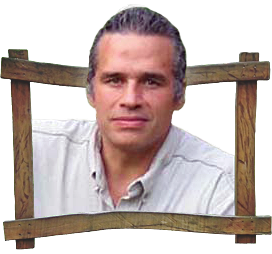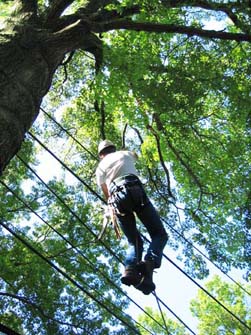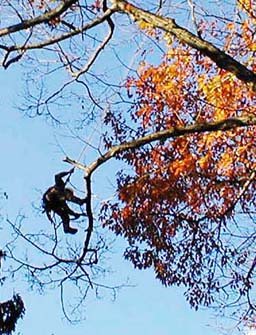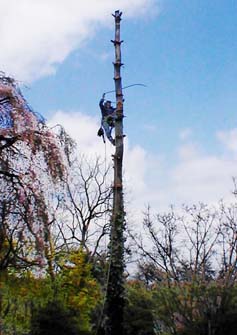Advanced climbing techniques are primarily used for tree pruning and cabling. They also improve the efficiency and safety of tree removals, though to a lesser degree. Tree removals are generally performed with the use of climbing spikes, which tend to “level the playing field” between “old school” and new school climbers. Advanced climbing techniques and equipment are most critical when it comes to pruning and cabling large trees. It is very difficult to get into the upper canopy of a 75’-100’+ tree without the use of a throw line to set a high climbing, and the use of ascenders to footlock up the climbing line. Whereas a smaller tree in the 35-50’ range, can be reached by the lesser skilled arborists with a tall ladder or bucket truck.
Old school arborists and landscapers tend to do inferior pruning and cabling in larger trees because they simply cannot reach the branch tips in the upper canopy. The result is that they tend to set their climbing lines in relatively low crotches, and remove large limbs at the trunk, in the middle and lower areas of the canopy, rather than making smaller cuts on the branch tips in the upper canopy. This can be very detrimental to the tree’s health and longevity. Large wounds on the trunk (anything over 4-6” diameter depending on species) will often result in unstoppable decay which will eventually destabilize the tree’s entire structure (see Melvin prune video). Removing lower limbs (often called elevating or raising the canopy) can expose the trunk and root system to direct summer sun, which is extremely stressful for trees, because they have evolved to grow in wooded settings where direct sun in these areas is non-existent. This type of inferior pruning often does more harm than good and unfortunately, is far too common in the local industry, which is completely unregulated by the state of Pennsylvania or local municipalities.
The use of advanced climbing equipment and techniques is a sure sign that your arborist cares enough about good tree care to keep up with continuing education in this and other areas. One sure sign that your arborist is using advanced climbing techniques is the use of footlocking for ascending into the canopy. Daniel published his second article, called “The Fundamentals and Fine Points of Footlocking” in June, 2006, which was at the time described by one leading industry expert as “the most complete information on the subject published to date in either writing or video.” And again he was put on the cover of Tree Care Industry Magazine, the largest trade journal for professional arborists in the world.
The use of advanced climbing techniques also gives new school climber a distinct competitive advantage in quality and productivity, which translates into good value for his clients. This page will show the differences between “old school” and “new school” techniques and equipment. My hope is to both educate potential clients about the type of equipment needed to do first rate tree work so that they may make an informed choice about which tree care company to hire, and to inspire my peers to “get with the program” and adopt these new techniques.
Ascending:
Old school: Climber uses ladders and a pole saw to set and advance a climbing line in the tree.
New school: Climber uses a throw line and throw bag to set a pilot line high in the canopy with either a large sling shot, or the more skilled can throw by hand. The pilot line is then used to set a climbing line. Once the climbing line is set the climber can either ascend using footlocking for pruning, or can be belayed from the ground while spiking up the tree for removals.
Pruning:
Old school: Climber sets a climbing line relatively low in the canopy and performs some combination of either using a pole saw to reach out to make cuts on the branch tips (which results inevitably in sloppy and misplaced target cuts) or simply coming down the trunk and removing every 4th or 5th branch on the trunk. These tend to be large limbs that require the use of a chainsaw to remove. This is a common practice that can devastate a healthy tree, and is handled by some species far better than others.
New school: Climber will limb walk out to the branch tips and make cuts with a high tech handsaw, enabling him to remove weight from the branch tips, which is where the leverage is, while still making small, well placed target cuts, which the tree can easily seal over. New school climbers move through the entire canopy of a large tree with ease and fluidity. Because they can reach the branch tips and therefore do not need to make large cuts, they will often forgo the use of a chainsaw for pruning and simply carry an extremely sharp and sturdy hand saw. This technique frees the climber from the need to carry a heavy saw throughout the canopy, which is very cumbersome when limb walking and moving through tight areas. And it allows the climber to make many smaller cuts more quickly and accurately than could be done with a chainsaw.







